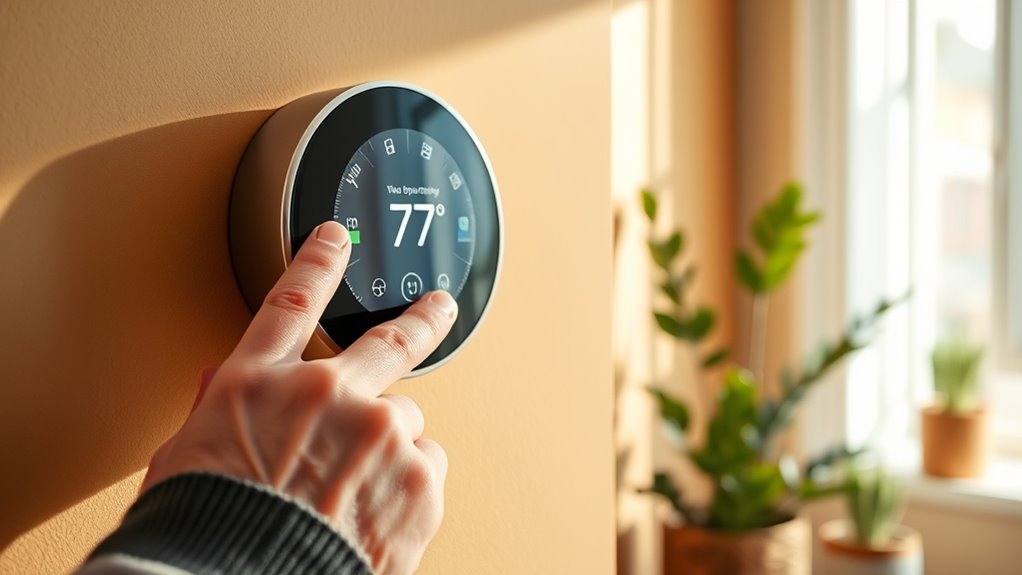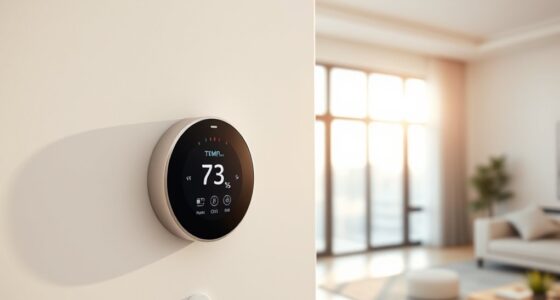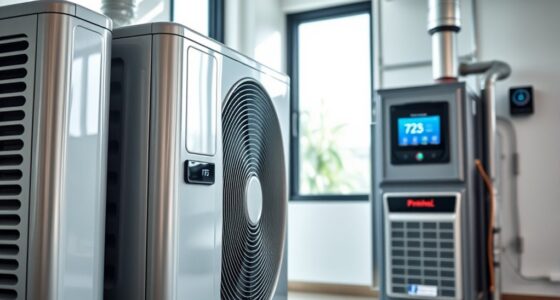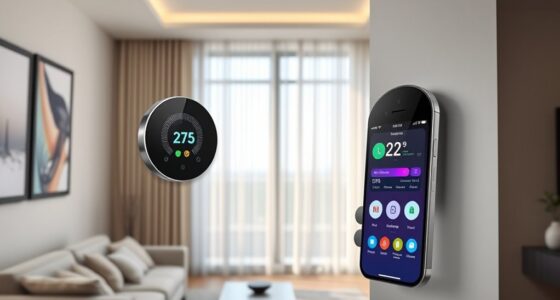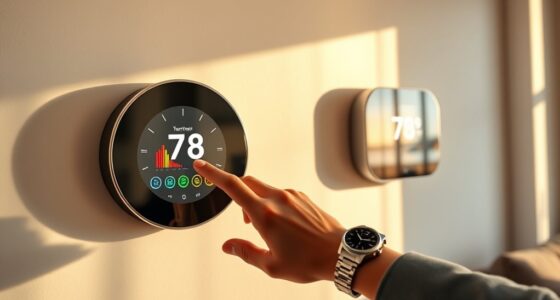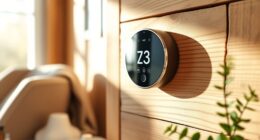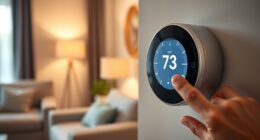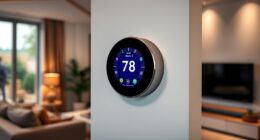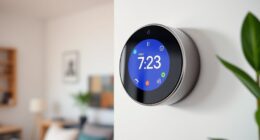Smart thermostats support aging in place by automatically adjusting your home’s temperature to keep you comfortable and safe. They learn your preferences, so you don’t have to constantly change settings, and can alert you if temperatures become unsafe. You can control them remotely or with voice commands, helping maintain independence. These features promote safety, energy efficiency, and peace of mind—discover how these smart solutions can make life easier and safer for you.
Key Takeaways
- Enable remote temperature control for easy adjustments without physical access.
- Provide alerts for unsafe temperature levels, promoting safety and early intervention.
- Learn user habits to automatically maintain comfortable, personalized environments.
- Support voice commands and simple interfaces, aiding users with limited mobility or technical skills.
- Offer continuous monitoring and notifications, fostering independence and peace of mind.
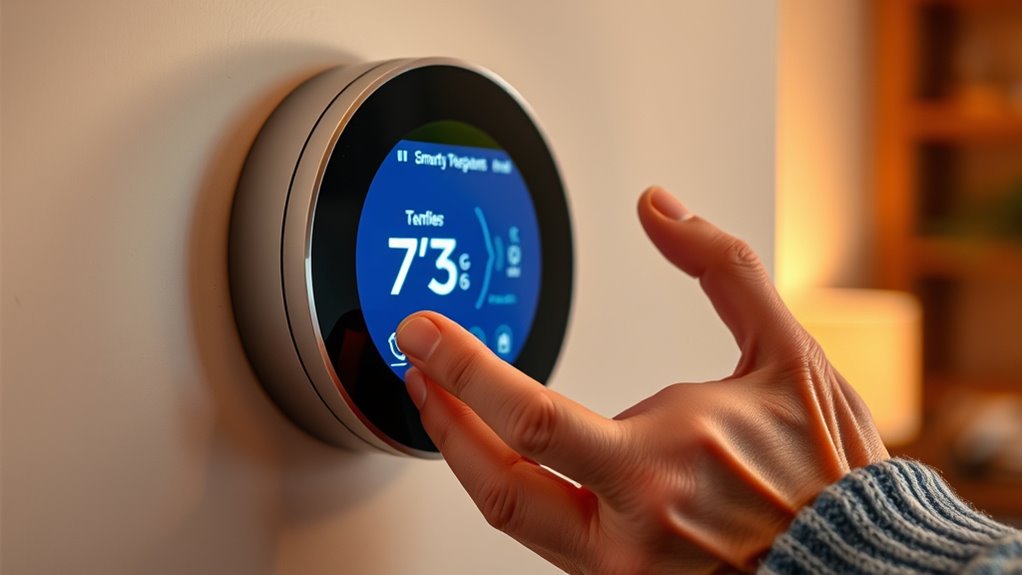
As more seniors choose to age in place, smart thermostats have become a valuable tool for maintaining comfort and safety at home. These devices help you manage your home’s temperature efficiently, ensuring that your living environment stays just right without wasting energy. With smart thermostats, you can customize your heating and cooling schedules to match your daily routines, which enhances energy efficiency and reduces utility bills. Instead of manually adjusting your thermostat multiple times a day, you can set it once and trust it to keep your home comfortable around the clock. This not only saves you money but also promotes a more sustainable lifestyle, which is especially important if you’re looking to stay independent over the long term.
Smart thermostats help seniors stay comfortable, safe, and energy-efficient at home.
User comfort is a primary focus of smart thermostats, and they are designed to adapt to your preferences seamlessly. Many models learn your habits over time, automatically adjusting the temperature when you’re home, away, or sleeping. This means you don’t have to think about constant adjustments; the thermostat does it for you, creating a consistently cozy environment. Additionally, some devices allow you to control your home’s temperature remotely via smartphone or voice commands, giving you the flexibility to make adjustments from anywhere. If you feel chilly in the evening or warm during the day, you can change settings instantly, ensuring you stay comfortable at all times. Incorporating smart home technology can further enhance your ability to monitor and control your environment effortlessly.
Smart thermostats also contribute to safety by providing alerts if your home’s temperature dips too low or rises too high, which can prevent issues like frozen pipes or overheating. These alerts can be sent directly to your phone, so you’re always informed about your home’s climate, even if you’re not physically there. This added layer of security reassures you and your loved ones that your environment remains safe, especially during extreme weather conditions. Moreover, understanding energy efficiency principles can help you maximize your savings and reduce your environmental impact over time.
Another advantage is ease of use. Many models feature intuitive interfaces and voice control compatibility, making it simple to operate even if you’re not tech-savvy. This reduces frustration and encourages consistent use, helping you maintain ideal energy efficiency and comfort. Furthermore, understanding Nissan Tuning concepts such as performance upgrades can inspire you to explore ways to optimize your home’s energy systems for better efficiency and sustainability over time. Over time, the convenience of managing your home’s temperature with minimal effort enhances your independence and peace of mind.
Frequently Asked Questions
How Do Smart Thermostats Detect Falls or Emergencies?
Smart thermostats typically don’t detect falls or emergencies directly. However, with integrated sensors or connected devices, they can support fall detection and emergency alerts. For example, if a connected smart home system notices unusual activity or a sudden lack of movement, it can trigger alerts. This way, you get timely emergency notifications, providing peace of mind and immediate help if a fall or emergency occurs in your home.
Can Smart Thermostats Be Integrated With Medical Alert Systems?
Think of your home as a well-connected web, where smart thermostats can be the central hub. Yes, they can integrate with medical alert systems, enhancing your home security and connectivity options. By linking these systems, you can easily trigger alerts or adjust settings during emergencies. This seamless integration guarantees you stay safe and comfortable, giving you peace of mind knowing your home responds swiftly to your needs.
Are There Specific Models Recommended for Seniors With Disabilities?
If you’re looking for smart thermostats for seniors with disabilities, choose models with voice control and accessibility features. These options make it easier for you to adjust settings without physical effort. Brands like Nest and Ecobee offer user-friendly interfaces, voice commands, and large displays, helping you stay comfortable and independent. Always check for compatibility with other assistive devices to ensure seamless integration and maximum support.
How Does Energy Savings Benefit Aging in Place?
Energy efficiency and cost savings make aging in place easier for you. When your home uses energy wisely, your utility bills decrease, reducing financial strain. Smart thermostats help optimize heating and cooling, ensuring your home stays comfortable without wasting energy. This balance supports your independence by making your living environment more affordable and sustainable, allowing you to focus on enjoying your space safely and comfortably as you age.
What Training Is Needed for Seniors to Use Smart Thermostats Effectively?
You need to guarantee seniors receive proper training requirements and user education to use smart thermostats effectively. This involves simple, clear instructions on adjusting temperature settings and understanding features. Hands-on demonstrations and easy-to-follow guides help build confidence. Providing ongoing support and accessible resources also ensure they can operate the device independently, making their homes safer and more comfortable while promoting independence in aging in place.
Conclusion
As you consider smart thermostats for aging in place, remember they do more than just control temperatures—they offer peace of mind. Imagine a future where your home anticipates your needs, ensuring comfort and safety at every turn. But what if this technology holds even more surprises? The potential for smarter, safer living environments is just beginning. Are you ready to discover how much your home can truly do for you? The next breakthrough might be closer than you think.
